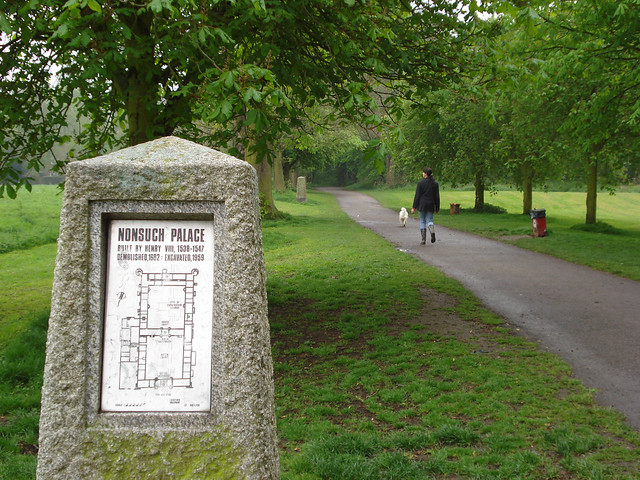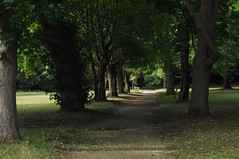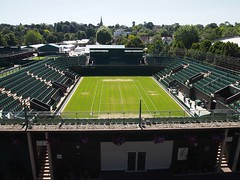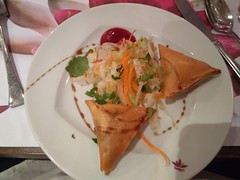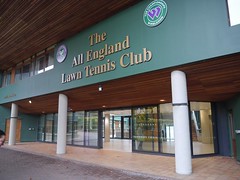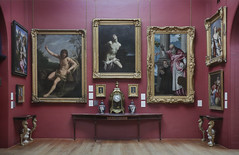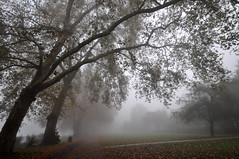Cheam
Cheam (English: /ˈm/) is a suburb of London, England, south-west of Charing Cross. It is divided into North Cheam, Cheam Village and South Cheam. Cheam Village contains the listed buildings Lumley Chapel and the 16th-century Whitehall. It is adjacent to two large parks, Nonsuch Park and Cheam Park. Nonsuch Park contains the listed Nonsuch Mansion. Parts of Cheam Park and Cheam Village are in a conservation area. Cheam is bordered by Worcester Park to the north-west, Morden to the north-east, Sutton to the east, Epsom, Ewell and Stoneleigh to the west and Banstead and Belmont to the south.
History
The Roman road of Stane Street forms part of the boundary of Cheam. The modern London Road at North Cheam follows the course of the Roman road through the area. It is designated A24.
The village lay within the Anglo-Saxon administrative division of Wallington hundred. Cheam is mentioned in the Charters of Chertsey Abbey in 727, which mentions Cheam being given to the monastery of Chertsey in 675; the name appears as Cegeham. However, the Charters are of dubious origin and are now regarded as obvious fabrications. The name 'Cheam', based on Cegeham, may mean 'village or homestead by the tree-stumps'.
Cheam appears in Domesday Book as Ceiham. Held by Archbishop Lanfranc of Canterbury, its Domesday assets were four hides, one church, 17 ploughs, of meadow, and woodland worth 25 hogs. It rendered £14.
In the Middle Ages, Cheam had potteries, and recent excavations have been carried out by archaeologists. In 1259, Henry III of England made Cheam a town by charter. In 1538, part of Cheam was handed over to Henry VIII. The same year, Henry began work on Nonsuch Palace, which he decorated elaborately. This was later sold and demolished.
In 1801, the time of the first census, Cheam had a population of 616 Cheamonians.
Cheam was the original home of Cheam School which was formed in Whitehall in 1645 and later occupied Tabor Court from 1719 until 1934 when the school moved to Berkshire. Prince Philip attended the school in the years immediately preceding its move.
Cheam Charter Fair
Every year on 15 May the Cheam Charter Fair is held. It is thought to date back to 1259 when Henry III granted Cheam a charter, making it a town. Firm historical records of Cheam Charter Fair date back to the 1800s when a fairground accompanied the market.
Cheam Village and North Cheam
Cheam Village is centred on the crossroads between Sutton, North Cheam, South Cheam and Ewell.
It has a conservation area and a number of historic buildings dating back several centuries, including Nonsuch Mansion, the gabled Whitehall and Lumley Chapel, and a Georgian former rectory.
The Cheam Village Conservation Area was designated in 1970 – it covers historic parkland, housing of varying styles and age and a mock Tudor shopping area with timber detailing and leaded-lights. The entrances to Cheam Park and Nonsuch Park with its historic mansion are approximately two hundred yards from the village centre crossroads.
North Cheam is centred north, at the crossroads between Cheam Village and Worcester Park, Epsom and Morden. Victoria Junction is the centre of North Cheam. The area consists of a large Sainsbury's supermarket with adjoining Starbucks, a neighbouring park, a number of independent shops and restaurants, a post office and a Costa Coffee. There are plans to redevelop the site of a vacant 1960s building at the North Cheam crossroad and expand commercial and residential buildings. St. Anthony's Hospital is a large private hospital in North Cheam.
Cheam Leisure Centre, on Malden Road, has facilities including a swimming pool (30m x 12m), squash courts and fitness gym.
Places of note
Whitehall
Whitehall is a timber framed and weatherboarded house in the centre of Cheam Village. It was originally built in about 1500 as a wattle and daub yeoman farmer's house but has been much extended. The external weatherboard dates from the 18th century. In the garden there is a medieval well which served an earlier building on the site.
Now an historic house museum, the building features a period kitchen, and house details from the Georgian, Victorian and Edwardian eras. The museum temporarily closed in 2016 to allow for a £1.6m refurbishment of the building. It reopened in June 2018 with improved facilities.
Cheam War Memorial
Close to Cheam Library and the much-rebuilt Church, the memorial is to the people of Cheam who lost their lives during World War I, World War II and the Falklands War.
There are a number of inscriptions on the structure, including one at the 12 O'Clock Face which reads:
It was designated a Grade II listed building by English Heritage in December 2016.
The Old Rectory
The Old Rectory is a large part timber-framed house, built in the Tudor period, but extended and remodelled in the 18th century. It is occasionally open to the public.
The Old Cottage
The Old Cottage was built in the late 15th or early 16th century. Initially built as a cottage, it became a small brewery in the 18th century. It originally stood in the Broadway (then Malden Road) near the junction with Ewell Road. Under threat of demolition when the road was widened in 1922, it was saved by the local council, working with a local architect and historian.
The building was dismantled by removing the original wooden pins from the timber frame. The parts were then moved to the present site one hundred yards down the road and reassembled. The Old Cottage features a local historical plaque, and was used as a bridalwear shop before becoming a woolshop in 2022.
The Old Farmhouse
A large timber-framed and weatherboarded yeoman farmer's house, forming part of the Cheam Conservation Area with St Dunstan's Church, Whitehall, The Old Rectory and the Lumley Chapel, the Old Farmhouse has a crown post roof and large Tudor axial chimney stack in the centre with large fireplaces. The earliest part of the house is 15th century, with several building stages extending the house in the 16th and 17th centuries, creating a Baffle House design popular in the 17th century.
Many original features remain including oak doors and hinges, window shutters and fireplaces. Much of the timber framing is exposed throughout the house. Recent excavation and ground imaging uncovered a large Tudor kitchen underneath the house with a Tudor hearth and hood visible. Access to the cellar kitchen was by a staircase going north to south, which is now under the floor of the current kitchen. A file of text and images relating to the house is available in the Conservation Archive in Sutton Library.
Nonsuch Mansion
Nonsuch Mansion is a Grade II listed Gothic revival mansion within Nonsuch Park. The Service Wing Museum is open to the public during the summer on Sundays. It is run by the Friends of Nonsuch, which charitable organisation also commissioned the largest model of Nonsuch Palace available. The model was created by designer Ben Taggart and can be seen throughout the year on Sundays. The mansion itself is a popular place for wedding receptions, as is available for hire. In medieval times the land upon which Nonsuch Mansion sits was part of the three thousand acre manor of Cuddington. The mansion was originally built in 1731–1743 by Joseph Thompson and later bought by Samuel Farmer in 1799. He employed Jeffry Wyattville to rebuild it in a Tudor Gothic style in 1802–1806. Farmer was succeeded by his grandson in 1838 under whom the gardens became famous.
Nonsuch Mansion bears a resemblance to the original design of Nonsuch Palace, whose construction was begun by King Henry VIII in the 16th century. Built within the north porch of the mansion is a block from the original Nonsuch Palace that bears an inscription which means "1543 Henry VIII in the 35th year of His reign."
Places of worship
St Dunstan's Church is the area's parish church, situated in Cheam Village, next to Lumley Chapel. St Paul's Howell Hill is on Northey Avenue at the far west of the town, although it is actually in the borough of Epsom and Ewell. It is known locally due to its prominent presence on a roundabout and its contemporary design. Towards the eastern end of Northey Avenue is St Andrew's United Reformed Church, a grade II listed building designed by Maxwell Ayrton in 1933. Cheam Baptist Church is located next to St Dunstan's Church. Cheam Methodist Church is in the east of the town just off the A217 and is also home to Sutton Schoolswork, the local Christian schools charity working in the borough of Sutton.
St Dunstan's Church
The parish church of St. Dunstan is Grade II* listed. It was built in Cheam Village in 1864 next to Lumley Chapel on the site of a medieval church. It was built with Kentish ragstone below pitched slate roofs, with dressings to windows and doors in Bath Stone. It was designed by F. H. Pownall in the Gothic revival architectural style, and features polychrome brickwork decoration internally. The lychgate, dated 1891, at the entrance to the churchyard, is listed Grade II. In the churchyard are three tombs which are Grade II listed.
The graveyard attached to this church was twice subject to a archaeological excavation by the police, first between June and September 2012, and again from April 2013. This excavation was conducted in order to uncover evidence in the investigation into the unsolved disappearance of Lee Boxell, a fifteen-year-old local schoolboy, in 1988. The church was home to an informal youth club in the 1980s, known as 'The Shed'.
Lumley Chapel
Situated next to St Dunstan's Church, Lumley Chapel is the oldest standing building in the London Borough of Sutton, and contains many notable monuments to local families.
Following the construction of the new St Dunstan's church in 1864, the older church on the site was demolished, other than the east end of the chancel, which was retained to contain the monuments and brasses from the old church. This remnant of the former church is now known as the Lumley Chapel. It is constructed in partly roughcast rubble ston…
Looking for places related to Cheam?
Those are other destinations to find places related to Cheam:
